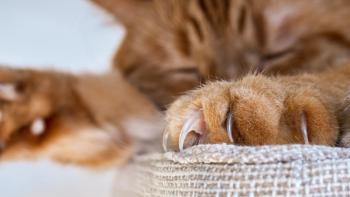
Risk Factors for Inappropriate Urination in Cats
A new study reveals that some commonly reported risk factors for urine marking and latrine behavior in cats may not play a role in the behaviors after all.
Inappropriate urination, or periuria, is a common complaint of cat owners. The behavior is a leading cause of relinquishment and sometimes results in euthanasia. Many risk factors for this behavior have been suggested, but most lack evidence-based support.
It is important to differentiate 2 types of periuria: marking and latrine behavior. For this study, latrine behavior included nonmarking urination outside the litter box. While several predictors have been suggested (eg, evaluation of posture or volume of urine deposited), data on sensitivity and specificity are lacking.
A recently published article in
RELATED:
- Urinary Incontinence—More Than an Inconvenience
- Behavior-based Pain Measurement in Animals
Study Design
An online survey was available in 2 languages (Brazilian Portuguese and UK English) from April to June 2016. Questions evaluated 41 risk factors and 15 predictors of periuria previously suggested by the literature. Significant predictors were evaluated further for sensitivity and specificity in differentiating marking from latrine behavior.
Cats were classified into 3 groups:
- Nonperiuric (by owner reporting)
- Marking
- Latrine behavior (by evaluation of answers by 2 veterinarians)
Risk factors and predictors of periuria were evaluated for each group using univariate statistical analysis and nonparametric tests of association.
Results
Brazilian and English survey results were significantly different in 3 areas: age (Brazilian median, 4 years; English median, 7 years), proportion of cats with no periuria (Brazilian, 34.7%; English, 54.7%), and proportion of cats displaying latrine behavior (Brazilian, 49.6%; English, 26.2%). Reproductive status, gender, pedigree, age range, and proportion displaying marking were similar.
The results of both surveys (n = 245) were pooled for analysis. The mean age of cats was 6.3 years (range, 6 months to 19 years). Males represented 51% of cats, with 93.5% being neutered. No history of periuria was reported in 113 cats (46.1%). Of the remaining 132 cats, 40 were classified as marking (30.3%) and 92 as latrine behavior (69.7%).
Multiple risk factors lacked a significant association with periuria, including gender, neuter status, pedigree, litter box attributes, medical history, and owner characterization of a nervous or aggressive personality.
The following risk factors were found to have significant associations:
- Cats in the marking group were significantly older (median, 9.5 years) than those with latrine behavior (median, 5 years) or no periuria (median, 4 years).
- Periuria in general was 3 times more likely if at least 1 other cat lived in the household (marking, 6 times more likely; latrine behavior, twice as likely).
- Latrine behavior was 5 times more likely in cats that defecated outside the litter box.
- Latrine behavior was less likely for cats that had some outdoor access.
- Latrine behavior was less likely in cats described as heavily owner-dependent.
- Marking was increased in cats with unrestricted outdoor access.
- Marking was less likely in cats described as having a relaxed personality.
When predictors of periuria were evaluated, four cardinal signs were identified: posture (standing versus squatting), surface chosen (vertical versus horizontal), attempts to cover the area after urinating, and the volume of urine deposited (small vs. large). These signs were evaluated for sensitivity and specificity, with the highest specificity for each behavior found for evaluation of posture and surface chosen.
Take-Home Message
The results of this study confirm outside access and multicat households as risk factors for periuria. Surprisingly, other commonly reported risk factors, including medical history, litter box attributes, and gender, lacked statistical significance; however, the authors stress that this study was designed to determine simple associations. Larger studies with multivariate analysis are needed in the future.
Additionally, the study highlights the importance of differentiating marking and latrine behavior, as risk factors differ for each. While individual signs can be used in diagnosing marking versus latrine behavior, use of multiple signs for differentiation is best.
Newsletter
From exam room tips to practice management insights, get trusted veterinary news delivered straight to your inbox—subscribe to dvm360.






